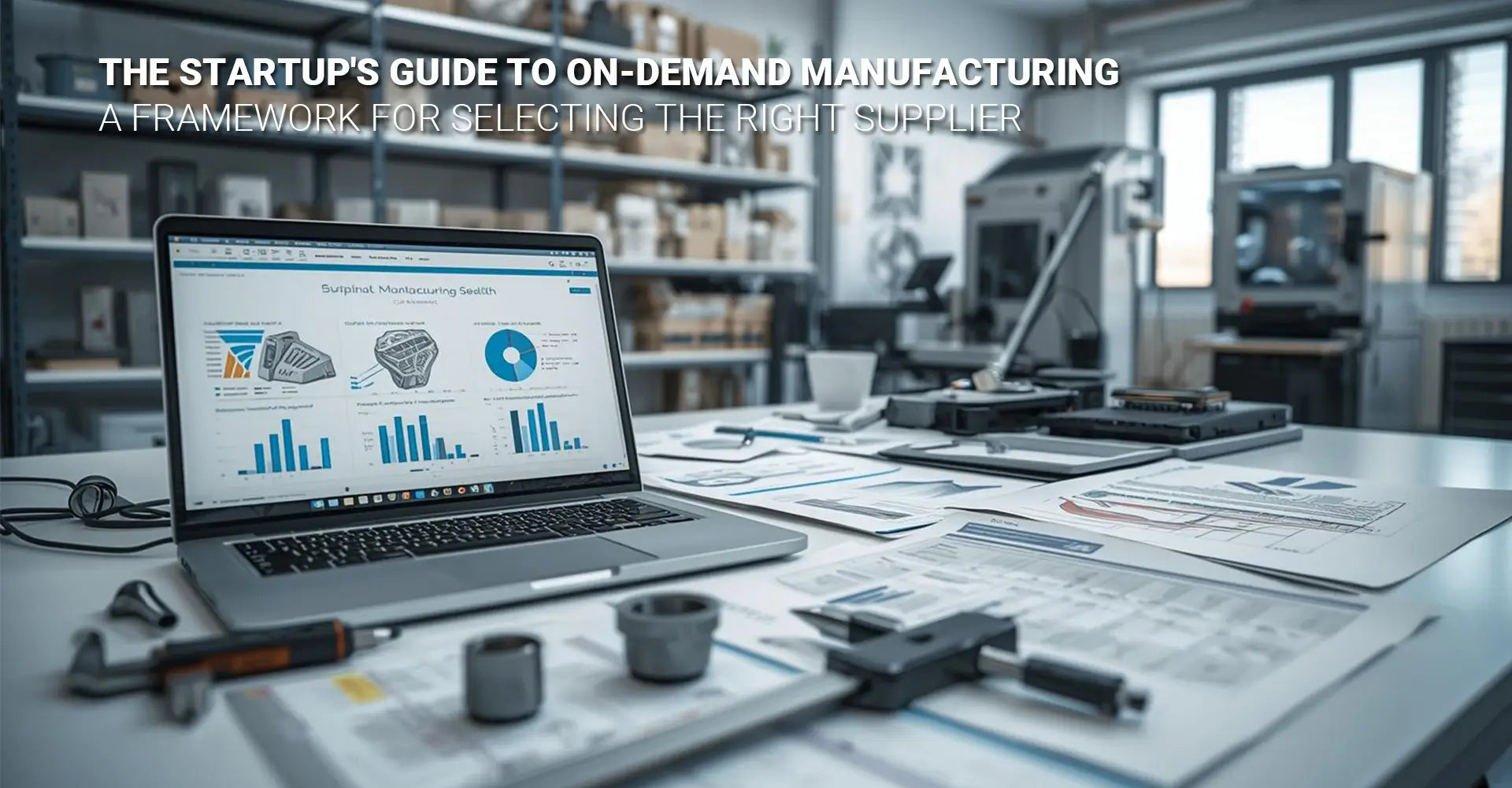How Do You Choose the Right On-Demand Manufacturing Supplier for Your Startup?

How Do You Choose the Right On-Demand Manufacturing Supplier for Your Startup?

Choosing a manufacturing partner can make or break your product launch. Many startups waste months and thousands of dollars on suppliers who promise fast turnarounds but deliver late, broken, or unusable parts. Consequently, these companies miss critical market windows and burn through limited budgets fixing preventable problems. Therefore, selecting the right supplier isn't just about finding someone who can make your parts—it's about finding a partner who understands your timeline, respects your budget, and delivers quality you can rely on. This guide provides a practical framework to evaluate suppliers before you commit, helping you avoid costly mistakes and build a relationship that supports your growth from prototype to production.
Quick Supplier Evaluation Checklist
Before diving into detailed assessments, here's what separates reliable partners from problematic ones:
| Evaluation Factor | Target Benchmark | Why It Matters |
|---|---|---|
| Quote Response Time | Under 24 hours | Shows process automation and responsiveness |
| On-Time Delivery Rate | 95% or higher | Directly impacts your launch schedules |
| DFM Feedback Quality | Detailed, proactive | Prevents costly design flaws before production |
| Defect Rate | Below 2% | Indicates strong quality control systems |
| Communication Style | Transparent, regular | Ensures you're never left guessing about status |
Key takeaway: A supplier who scores well across all five factors will save you time, money, and stress throughout your product development journey.
Now that you know what to look for, let's break down each factor in detail. Understanding why these metrics matter will help you ask the right questions and spot red flags during your supplier search. Moreover, this four-point assessment system will give you a clear framework to compare potential partners objectively. By the end of this article, you'll have the tools to conduct a thorough manufacturing supplier assessment and choose a partner who can grow with your business.
[Table of Contents]
- What Makes Response Speed Your First Real Test?
- How Can You Judge Quality Before Placing Large Orders?
- Why Does On-Time Delivery Matter More Than Price?
- What Red Flags Should Stop You From Signing a Contract?
What Makes Response Speed Your First Real Test?
Your first interaction with a potential supplier reveals everything about how they'll treat you as a customer. When you submit a quote request, you're not just asking for a price—you're testing their systems, their priorities, and their ability to handle your project efficiently. Additionally, quick quote response manufacturing demonstrates whether a supplier has invested in digital tools or still relies on slow, manual processes.
The Speed Test Results
Fast response = streamlined operations. Suppliers who provide quotes within 24 hours typically use automated quoting platforms that can quickly analyze your design files, calculate material costs, and estimate production time. In contrast, suppliers who take three to five days often rely on manual estimating, which means your project will move slowly at every stage.
However, speed alone doesn't tell the whole story. When you evaluate on-demand manufacturer options, pay close attention to what comes with that quote. The best suppliers include DFM feedback quality analysis that identifies potential manufacturing challenges before you commit to the design.
For example, excellent DFM feedback includes:
- Specific design modifications to reduce cost while maintaining functionality
- Material alternatives that better suit your application and budget constraints
- Clear explanations of why certain features may be difficult or expensive to produce
- Revised technical drawings showing recommended changes with detailed annotations
Furthermore, this proactive feedback saves you from discovering expensive design flaws after you've already paid for tooling or ordered materials. A supplier who simply quotes your design as-is—without any suggestions—will likely build whatever you send them, including costly mistakes that could have been avoided.
Think about it this way: if a CNC machining service provider notices that reducing a wall thickness by 1mm could cut your production cost by 30%, wouldn't you want to know before production starts? That's the difference between a transactional vendor and a true manufacturing partner.
Additionally, test their communication responsiveness during the inquiry phase. Send follow-up questions and see how quickly they respond. A supplier who takes days to answer simple questions before they have your business will almost certainly be slower once you're an established customer.
How Can You Judge Quality Before Placing Large Orders?
Trusting a new supplier with your product design feels risky, especially when you're working with tight budgets and demanding customers. Unfortunately, many suppliers make bold quality claims that fall apart once production begins. Therefore, you need concrete ways to verify their capabilities before committing to large production runs.
Start with certifications, but don't stop there. Look for ISO 9001 certification, which indicates the supplier follows documented quality management procedures. However, verify that the certification scope actually covers the services you need—some suppliers hold certifications for only part of their operations.

The most reliable way to assess supplier quality metrics involves requesting measurable performance data. Ask potential partners these specific questions:
"What is your first-pass yield rate?" This metric shows what percentage of parts pass inspection the first time without requiring rework. Rates above 95% indicate strong process control and skilled operators.
"What is your typical defect rate?" Reliable suppliers should report defect rates below 1-2%. Rates higher than this suggest inconsistent quality control or undertrained staff.
"Can I see a sample inspection report?" Review their standard quality documentation to understand what dimensions and tolerances they actually check. Detailed reports with multiple measurement points demonstrate thoroughness.
Moreover, the smart approach involves ordering a first-article sample before committing to larger volumes. This prototype run lets you physically inspect the quality, test the parts in your assembly, and verify that the supplier can meet your specifications. Although this adds time and cost upfront, it prevents much larger problems later.
For instance, if you're developing industrial machinery components, a single failed part can shut down an entire assembly line. Similarly, automotive applications demand extremely tight tolerances because safety depends on part reliability. In these cases, investing in sample validation is essential, not optional.
Another verification strategy involves asking about their inspection equipment and processes. Suppliers with coordinate measuring machines (CMMs), optical comparators, and documented inspection procedures generally produce more consistent results than those relying solely on basic hand tools.
Finally, consider working with platforms that pre-vet suppliers and provide independent oversight. These services reduce your risk by ensuring suppliers meet baseline quality standards before they're added to the network.
Why Does On-Time Delivery Matter More Than Price?
Setting the Delivery Stakes
Late deliveries create cascading problems throughout your business. When parts arrive behind schedule, you miss trade show deadlines, delay customer shipments, and waste team time firefighting problems instead of developing new products. Consequently, a supplier who consistently delivers late costs you far more than the money you might save on a lower quote.
The Delivery Rate Benchmark
Target on-time delivery rate manufacturing performance of 95% or higher. This isn't an arbitrary number—it represents the difference between suppliers who have robust production scheduling and those who constantly scramble to catch up. Additionally, this metric directly predicts whether you can reliably meet your own commitments to customers and stakeholders.
Understanding Delivery Reliability
When conducting on-demand manufacturing supplier selection, don't accept vague promises about delivery. Instead, request historical performance data showing their actual on-time delivery rates over the past 6-12 months. Suppliers confident in their performance will share this information readily, while those with poor track records will make excuses or refuse.
Furthermore, understand what "on-time" actually means in their system. Some suppliers measure from the date they promised, while others measure from an ideal production schedule. Ask specifically: "What percentage of orders ship by the date you originally quoted to the customer?"
The connection between delivery reliability and operational excellence runs deep. Suppliers who consistently hit deadlines typically have:
- Accurate capacity planning that prevents them from accepting orders they can't fulfill
- Reliable material supply chains with backup sources for critical components
- Well-maintained equipment that doesn't break down during production runs
- Experienced production teams who can anticipate and solve problems quickly
For example, a small batch manufacturing supplier who maintains 98% on-time delivery has clearly invested in systems and people to support reliable performance. In contrast, suppliers with rates below 85% are likely cutting corners somewhere—either by overcommitting capacity, using unreliable subcontractors, or failing to maintain their equipment properly.
Consider the total cost perspective as well. Imagine you receive a quote that's 15% cheaper than competitors, but the supplier only delivers on time 80% of the time. Those late deliveries will cost you in:
- Rush shipping fees to meet your customer commitments
- Lost sales from missed market opportunities
- Engineering time spent expediting orders and finding backup suppliers
- Damaged reputation from failing to deliver on your promises
Therefore, a slightly higher-priced supplier with 98% on-time delivery almost always provides better value than the cheapest option with poor reliability.
What Red Flags Should Stop You From Signing a Contract?
Opening the Warning Discussion
Even experienced product developers sometimes ignore warning signs during supplier selection because they're under pressure to move quickly. However, rushing into a relationship with a problematic supplier creates far bigger delays than taking an extra week to find the right partner. Recognizing these red flags early can save you from months of frustration and wasted resources.
Five Critical Warning Signs
Watch for these danger signals during your evaluation:
- Unusually low quotes that seem too good to be true
- Zero DFM feedback on obviously complex designs
- Slow pre-sale communication with delayed responses
- Vague quality promises without supporting data
- Lack of process transparency about production steps
[Sub-heading 4 Featured Image: Red flag checklist infographic with visual warning symbols]
Understanding Each Trap in Detail
Let's explore why each of these red flags matters and how they lead to bigger problems:
The Low Quote Trap
When a quote comes in 30-40% below all other suppliers, it usually means corners are being cut somewhere. These suppliers might be:
- Using lower-grade materials than specified
- Employing less-skilled operators who work faster but less carefully
- Skipping quality control steps to reduce costs
- Planning to increase prices after you're committed
Remember, manufacturing costs follow predictable patterns based on materials, machine time, and labor. A quote that defies these economics should trigger immediate skepticism. The prototype to production partner you choose should offer transparent, competitive pricing—not suspiciously cheap quotes that hide problems.
The Missing DFM Feedback Problem
If you submit a design with tight tolerances, thin walls, or complex geometries and receive only a price quote with no manufacturing suggestions, run away. This indicates the supplier either:
- Lacks the engineering expertise to spot potential problems
- Plans to build exactly what you sent, including expensive mistakes
- Doesn't care enough about your success to invest time in feedback
Quality suppliers view DFM analysis as a standard service that protects both parties. They know that fixing design issues before production starts saves everyone time and money.
The Communication Red Flag
Pay attention to how quickly suppliers respond during the courtship phase. If they take 2-3 days to answer simple questions now, they'll be even slower once they have your money. Similarly, watch for suppliers who:
- Avoid giving straight answers to technical questions
- Refuse to provide performance data or customer references
- Become defensive when asked about quality or delivery metrics
Strong communication during the inquiry phase predicts strong communication throughout production. Conversely, poor communication early means constant frustration later.
The Vague Quality Promises
Statements like "we have very high quality standards" or "our customers are very satisfied" mean nothing without data. Instead, look for specific metrics like:
- First-pass yield rates with actual percentages
- Defect rates calculated over meaningful time periods
- Certification details with scope and expiration dates
- Sample inspection reports from recent production runs
Moreover, suppliers who refuse to share this information either don't track it (bad sign) or don't like what the data shows (worse sign).
The Transparency Gap
Finally, be wary of suppliers who treat their production process like a black box. You should be able to get clear answers about:
- Lead time breakdown (how long each production step takes)
- Inspection procedures (what gets checked and how)
- Material sourcing (where materials come from)
- Production updates (regular status communication)
A supplier who stonewalls these questions either has something to hide or doesn't have organized systems. Either way, you'll spend the entire relationship wondering what's happening with your order.
Each of these red flags represents a fundamental problem that won't improve after you sign a contract. In fact, issues that appear during evaluation always get worse during production, never better. Therefore, trust your instincts and keep searching if something feels off.
Conclusion
Selecting the right manufacturing supplier requires looking beyond price quotes to evaluate response speed, quality systems, delivery reliability, and communication practices. Throughout this guide, we've shown that suppliers who respond quickly with detailed DFM feedback, maintain on-time delivery rates above 95%, provide concrete quality metrics, and communicate transparently make the best partners for growing startups.
The four-point evaluation framework—testing response speed, verifying quality capabilities, confirming delivery performance, and watching for red flags—gives you an objective way to compare potential partners. Moreover, this systematic approach prevents common mistakes like choosing the cheapest quote or trusting vague quality promises.
Remember that supplier selection is strategic, not transactional. The right partner becomes an extension of your team, helping you refine designs, control costs, and meet aggressive deadlines. In contrast, the wrong supplier creates endless problems that drain resources and delay your product launch.
Before your next supplier conversation, review the evaluation checklist at the beginning of this article and prepare specific questions about response times, quality metrics, and delivery performance. Furthermore, don't hesitate to request sample parts, inspection reports, and performance data—suppliers confident in their capabilities will gladly share this information.
Ultimately, investing time in thorough evaluation upfront saves months of frustration and thousands of dollars in wasted production costs. Your choice of manufacturing partner directly impacts whether your product succeeds in the market or dies from quality problems and delivery delays.
External Links Recommendation
[Manufacturing supplier assessment][^1]
[Supplier quality metrics][^2]
[Quick quote response manufacturing][^3]
[On-time delivery rate manufacturing][^4]
[DFM feedback quality][^5]
[Prototype to production partner][^6]
---
[^1]: Understanding manufacturing supplier assessments can enhance your supplier selection process and improve overall quality.
[^2]: Exploring supplier quality metrics helps in evaluating supplier performance and ensuring product quality.
[^3]: Understanding quick quote response can enhance your manufacturing efficiency and customer satisfaction.
[^4]: Improving on-time delivery rates is crucial for maintaining customer trust and optimizing operations.
[^5]: Understanding DFM feedback quality can enhance your product development process, ensuring better design and manufacturing outcomes.
[^6]: Finding the right partner for prototype to production can streamline your project, reduce costs, and improve product quality.





